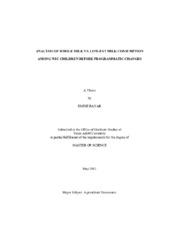| dc.description.abstract | The Special Supplemental Nutrition Program for Women, Infants, and Children (WIC) is one of the food assistance programs targeted at low-income women, infants and children up to age five by providing foods, nutrition education and other services. Recent updates in food packages provided by WIC include the addition of fruits, vegetables and whole wheat products as well as the removal of whole milk for women and children two years and older. This thesis concentrates on preschool children participants in the WIC program and their milk consumption habits prior to programmatic changes. Analyzing diet preferences of these children is crucial since a quarter of the population of children aged one thorough five participates in the WIC program; as well, they are not eligible to receive whole milk with WIC food packages after the implementation of revisions.
The objective is to describe the profile of preschool WIC children and their milk consumption attributes based on the National Food and Nutrition (NATFAN) questionnaire designed and conducted by the Institute for Obesity Research and Program Evaluation at Texas A & M University before the release of the revised WIC food packages. Additionally, findings of the study are compared with the National Health and Nutrition Examination Survey (NHANES) 2005-2006 dataset results. Milk consumption preferences of WIC children are analyzed nationwide and impacts of race, ethnicity, regional, and other demographic characteristics are observed. Using both NATFAN and NHANES datasets provides a comparison of actual and self-reported participation outcomes.
Discrete choice models were used in this analysis, in particular binary logit and multinomial logit models. The results of the thesis indicate that WIC preschool children mostly drink whole milk (36.17 percent) and 2 percent fat milk (49.94 percent). Two year old participants, children located in the South and participants whose caregivers are younger and less educated are more likely to consume whole milk. Caucasian children are less likely to choose whole milk and more likely to choose reduced fat milk; African Americans are more likely to select whole milk. Furthermore, diet preferences and knowledge of parents/caregivers play a major role on milk consumption of children. Children whose caregivers are willing to give low-fat milk to children aged two to five are less likely to drink whole milk. | en |


